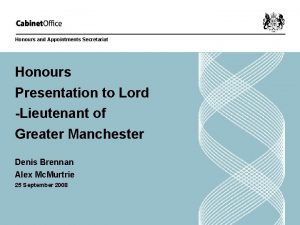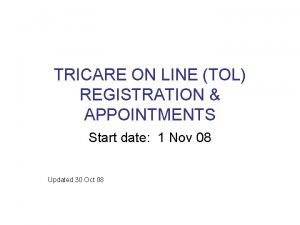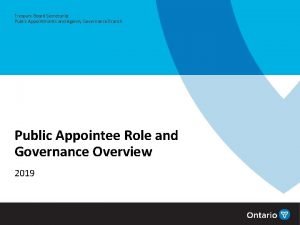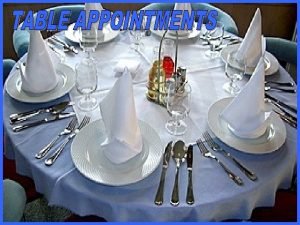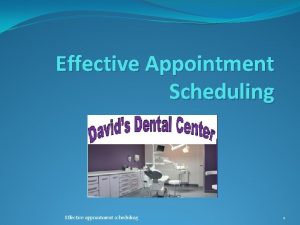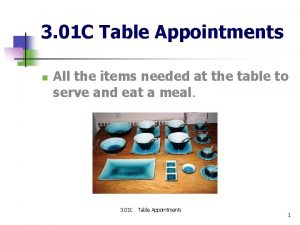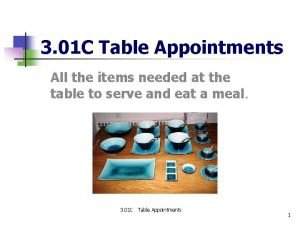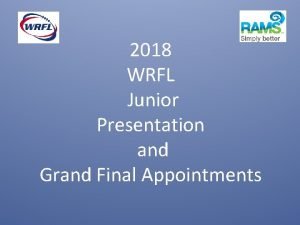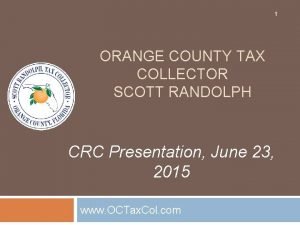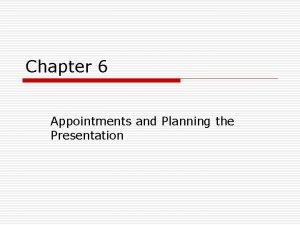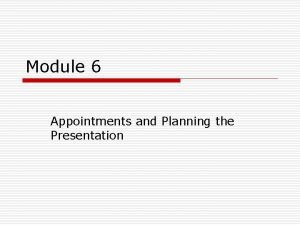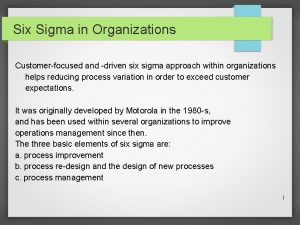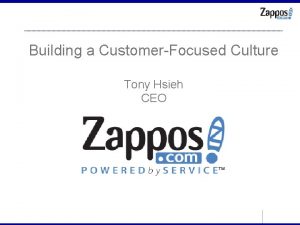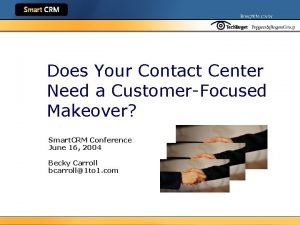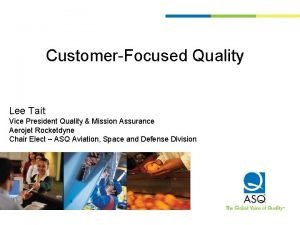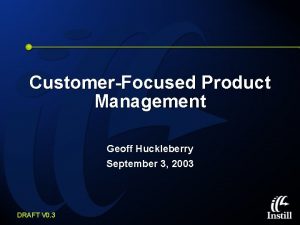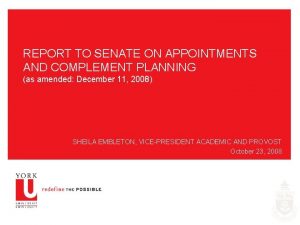Chapter 6 Appointments and Planning the Presentation CustomerFocused























- Slides: 23

Chapter 6 Appointments and Planning the Presentation

Customer-Focused Sales Dialogue Sales Calls Need Discovery Sales Presentations Throughout the process, the selling strategy must focus on customer needs and how the customer defines value. Follow-Up; Build More Value Sales dialogue occurs over time and includes sales calls and other forms of buyer-seller communication.

Linking Solutions to Needs Salespeople should strive to communicate to the buyer. . . o How the buyer’s needs will be met or how an opportunity can be realized as a result of a purchase. o How the product/service features translate, in a functional sense, into benefits for the buyer. o Why the buyer should purchase from the salesperson as opposed to a competitive salesperson. o If you talk with your prospect about the things that concern him/her, you’ll always have an attentive listener

Getting the Appointment o Experienced sales representatives try to schedule appointments in advance o Appointments are efficient o Appointments allow customers to see salespeople at their convenience, and to prepare for such meetings if necessary

Important Pre-Approach Information (from previous chapter(s)) Examples include: o Client name and pronunciation o Risk/type of buying situation o Communication style/profile of the buyer (may not be able to assess till several visits) o What is the market position of the company o Major competitor(s) of the company o Industry condition/intelligence o Challenges the organization may be facing o Company characteristics – size, division, decision makers, etc.

Setting the Appointment o Most commonly used methods: n Telephone n In-person calls n Letters n Email n Third party introductions What are the Strengths and weaknesses of each method?

Third Party Referral o Third party referral is an extension of the referral technique of prospecting o The satisfied customer may be asked not only to supply names of prospects but also to write a note introducing you to that prospect o This technique is particularly effective in industrial (B 2 B) situations

Types of Sales Presentations Canned Presentation Little training is required; inflexible/not customizable; difficult to build trust Organized Presentation Extensive training is required; customizable; interactive; fosters trust Written Proposal Some training is required; customizable while being written but not once delivered; may be perceived as more credible

Canned Presentations Hello ___, My name is _____. I want to tell you about. . . o Include n Scripted sales calls n Memorized presentations n Automated presentations o Should be tested for effectiveness o Must assume buyers’ needs are the same

Written Presentations o The proposal is a complete self-contained sales presentation o Customer may receive proposal and a followup call to explain and clarify the proposal. o Thorough assessment should take place before a customized proposal is written o Common parts to written proposals include: n n n Executive Summary Customers needs and proposed solution Seller profile Pricing and Sales Agreement Implementation and timetable

Organized Sales Dialogues and Presentations o Addresses individual customer and different selling situations. o Allow flexibility to adapt to buyer feedback o Most frequently used format for sales professionals

Sales Dialogue and Presentation Template (Exhibit 6. 4) Section 1: Prospect Information Section 2: Customer Value Proposition Section 3: Sales Call Objective Section 4: Linking Buying Motives, Benefits, Support Information and Reinforcement Method

Sales Dialogue and Presentation Template Section 5: Competitive Situation Section 6: Beginning the Sales Dialogue Section 7: Anticipate Questions and Objections Section 8: Earn Prospect Commitment Section 9: Build Value through Follow-up Action

Establishing Sales Call Objectives 1. Primary objectives (targeted outcome) 2. Minimum objectives (lowest acceptable outcome) Establishing Sales Call Objectives 3. Optimal objectives (best possible outcome)

Establishing Sales Call Objectives Use “S M A R T” steps to set sales objectives: Specific: Establish a specific, major objective for the sales call. Measurable: Ensure that your major objective is measurable or quantifiable, e. g. , a certain number of units or dollar sales volume. Achievable: Make sure the goals you set are realistic and achievable. Relational: Always try to develop a long-term relationship with the prospect even if the major objective on this sales call is not achieved. Why? Temporal: If you can, establish with the prospect a specific timeframe for achieving the major objective.

Common Sales Calls Objectives Ultimately, most sales calls should achieve one or more of three overall objectives: 1. Generate sales: Sell particular products to target customers on designated sales calls 2. Develop the market: Lay the groundwork for generating new business by educating customers and gaining visibility with prospective buyers 3. Protect the market: Learn competitors’ strategies and tactics and protect relationships with current customers

Approaching the Customer Presentation Strategy o Three approaches: n Non-product Approach n Consumer-Directed Approaches n Product-related Approaches Sales

Non-Product Related Approaches Self-introduction Dramatic act Non-Product Related Approaches Free gift or sample Mutual acquaintance or reference

Consumer-Directed Approaches Question Consumer-Directed Approaches Survey Compliment or praise

Product-Related Approaches Product demonstration Product-Related Approaches Product or Ingredient

First Impressions o Ask for permission to sit o Never clutter the prospect’s desk without asking for permission o Watch the tone of your voice o Always be courteous but not overly friendly or pushy o Never be presumptuous

Video Analysis

Video Clips Look for the following: o Relationships o Buying situation o Approaches to selling and leading-off o Product Considerations n Knowledge n Industry o Ethical considerations o Transition question(s) o Implication questions and Questioning Systems
 Honours and appointments secretariat
Honours and appointments secretariat Table appointment dinnerware
Table appointment dinnerware York eye hospital
York eye hospital Tricareon line
Tricareon line Public appointments secretariat
Public appointments secretariat Table appointments with pictures
Table appointments with pictures Examples of table appointments
Examples of table appointments Grade forgiveness fau
Grade forgiveness fau How to schedule appointments with clients
How to schedule appointments with clients Harding made several distinguished appointments to his
Harding made several distinguished appointments to his Classification of table appointments
Classification of table appointments Holloware
Holloware Visitors with appointments
Visitors with appointments Wrfl umpire appointments
Wrfl umpire appointments Dmv orlando appointment university
Dmv orlando appointment university Mentovertical diameter
Mentovertical diameter 4 maneuvers of leopold
4 maneuvers of leopold Inactivism planning
Inactivism planning Long term plan and short term plan
Long term plan and short term plan Figurative language slideshare
Figurative language slideshare Hình ảnh bộ gõ cơ thể búng tay
Hình ảnh bộ gõ cơ thể búng tay Lp html
Lp html Bổ thể
Bổ thể Tỉ lệ cơ thể trẻ em
Tỉ lệ cơ thể trẻ em
